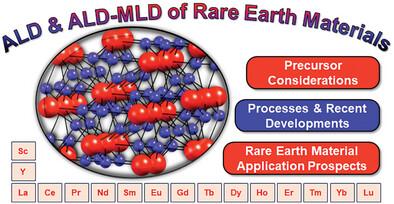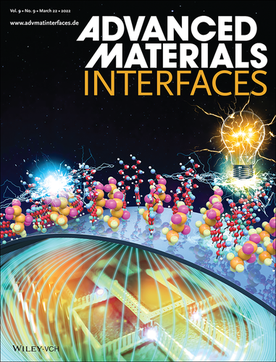Atomic and Molecular Layer Deposition of Functional Thin Films Based on Rare Earth Elements
IF 4.3
3区 材料科学
Q2 CHEMISTRY, MULTIDISCIPLINARY
引用次数: 0
Abstract
High‐quality rare earth element (

基于稀土元素的原子和分子层沉积功能薄膜
从(光)电子学、能量转换/存储到医疗诊断、成像和安全技术,各种应用领域都需要高质量的稀土元素 (R) 薄膜。原子层沉积 (ALD) 可提供大面积均匀、保形的超薄薄膜,是满足稀土元素薄膜潜在应用要求的独特选择。其历史始于 20 世纪 90 年代,当时利用 ALD 制备了第一批掺杂 R 的电致发光薄膜。很快,人们的兴趣扩展到将稀土元素氧化物层作为半导体器件中的高 K 栅极电介质,后来又扩展到具有新型功能特性的复杂三元和四元包晶氧化物。与原子/分子层沉积(ALD/MLD)相结合的最新进展迅速扩大了具有迷人发光和上转换特性的 R 有机杂化材料家族。本综述将介绍 R 基薄膜的 ALD 和 ALD/MLD 研究的最新进展,并重点介绍其应用潜力。
本文章由计算机程序翻译,如有差异,请以英文原文为准。
求助全文
约1分钟内获得全文
求助全文
来源期刊

Advanced Materials Interfaces
CHEMISTRY, MULTIDISCIPLINARY-MATERIALS SCIENCE, MULTIDISCIPLINARY
CiteScore
8.40
自引率
5.60%
发文量
1174
审稿时长
1.3 months
期刊介绍:
Advanced Materials Interfaces publishes top-level research on interface technologies and effects. Considering any interface formed between solids, liquids, and gases, the journal ensures an interdisciplinary blend of physics, chemistry, materials science, and life sciences. Advanced Materials Interfaces was launched in 2014 and received an Impact Factor of 4.834 in 2018.
The scope of Advanced Materials Interfaces is dedicated to interfaces and surfaces that play an essential role in virtually all materials and devices. Physics, chemistry, materials science and life sciences blend to encourage new, cross-pollinating ideas, which will drive forward our understanding of the processes at the interface.
Advanced Materials Interfaces covers all topics in interface-related research:
Oil / water separation,
Applications of nanostructured materials,
2D materials and heterostructures,
Surfaces and interfaces in organic electronic devices,
Catalysis and membranes,
Self-assembly and nanopatterned surfaces,
Composite and coating materials,
Biointerfaces for technical and medical applications.
Advanced Materials Interfaces provides a forum for topics on surface and interface science with a wide choice of formats: Reviews, Full Papers, and Communications, as well as Progress Reports and Research News.
 求助内容:
求助内容: 应助结果提醒方式:
应助结果提醒方式:


